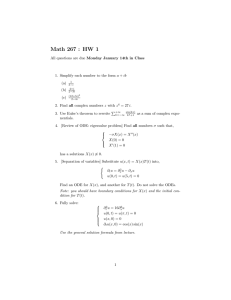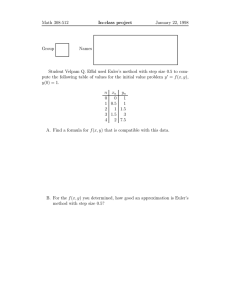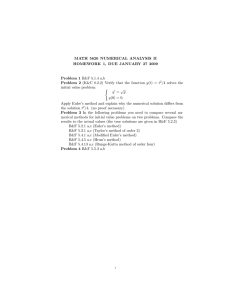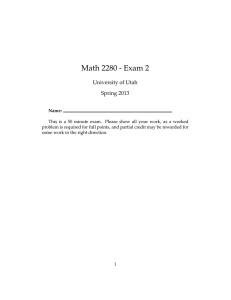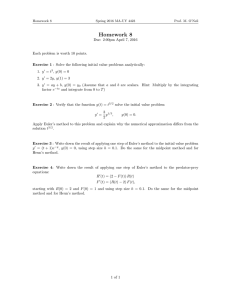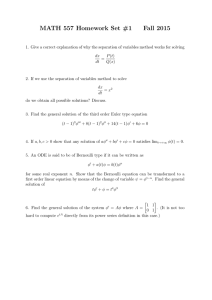Introduction to Numerical Analysis I Handout 16 1 Approximation of ODE
advertisement
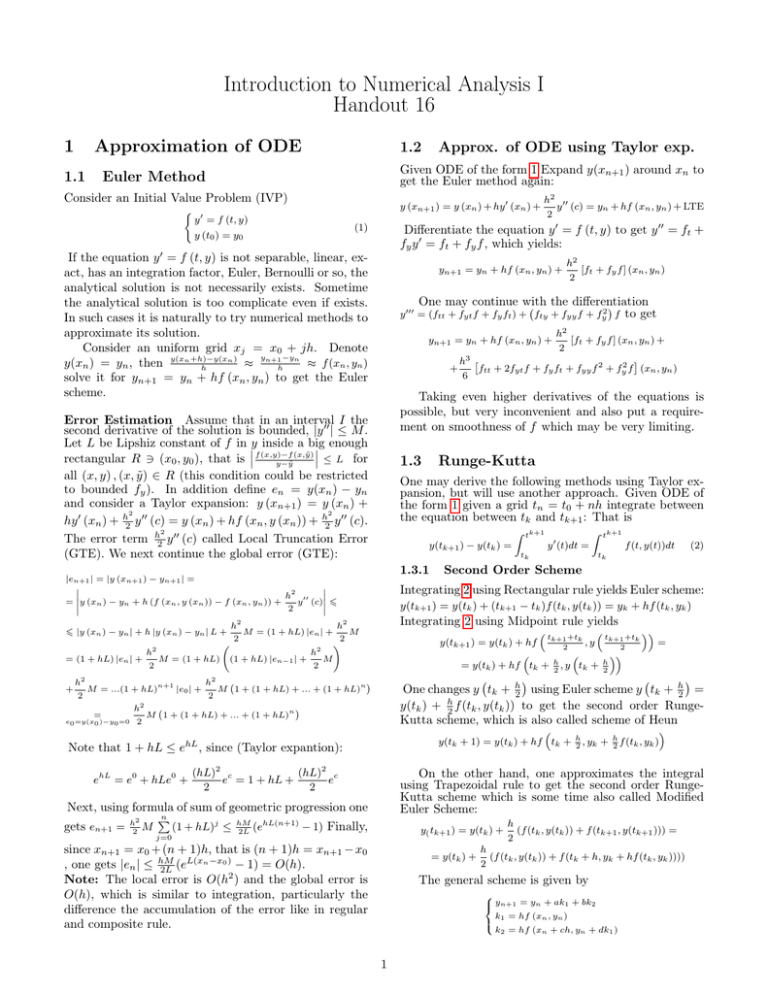
Introduction to Numerical Analysis I Handout 16 1 1.1 Approximation of ODE 1.2 Given ODE of the form 1 Expand y(xn+1 ) around xn to get the Euler method again: Euler Method Consider an Initial Value Problem (IVP) ( y (xn+1 ) = y (xn ) + hy 0 (xn ) + y 0 = f (t, y) If the equation y 0 = f (t, y) is not separable, linear, exact, has an integration factor, Euler, Bernoulli or so, the analytical solution is not necessarily exists. Sometime the analytical solution is too complicate even if exists. In such cases it is naturally to try numerical methods to approximate its solution. Consider an uniform grid xj = x0 + jh. Denote y −y n) y(xn ) = yn , then y(xn +h)−y(x ≈ n+1h n ≈ f (xn , yn ) h solve it for yn+1 = yn + hf (xn , yn ) to get the Euler scheme. yn+1 = yn + hf (xn , yn ) + h2 [ft + fy f ] (xn , yn ) + 2 3 h + ftt + 2fyt f + fy ft + fyy f 2 + fy2 f (xn , yn ) 6 yn+1 = yn + hf (xn , yn ) + Taking even higher derivatives of the equations is possible, but very inconvenient and also put a requirement on smoothness of f which may be very limiting. 1.3 = (1 + hL) |en | + h M = (1 + hL) 2 Z 1.3.1 (2) Second Order Scheme t +t t +t y(tk+1 ) = y(tk ) + hf k+12 k , y k+12 k = , y tk + h = y(tk ) + hf tk + h 2 2 One changes y tk + h2 using Euler scheme y tk + h2 = y(tk ) + h2 f (tk , y(tk )) to get the second order RungeKutta scheme, which is also called scheme of Heun y(tk + 1) = y(tk ) + hf tk + (hL)2 c (hL)2 c e = 1 + hL + e 2 2 hM 2L f (t, y(t))dt tk y(tk+1 ) = y(tk ) + (tk+1 − tk )f (tk , y(tk )) = yk + hf (tk , yk ) h h M = (1 + hL) |en | + M 2 2 ! 2 h (1 + hL) |en−1 | + M 2 (1 + hL)j ≤ j=0 tk+1 Integrating 2 using Midpoint rule yields 2 h , yk 2 + h f (tk , yk ) 2 On the other hand, one approximates the integral using Trapezoidal rule to get the second order RungeKutta scheme which is some time also called Modified Euler Scheme: Next, using formula of sum of geometric progression one n P Z Integrating 2 using Rectangular rule yields Euler scheme: Note that 1 + hL ≤ ehL , since (Taylor expantion): h2 M 2 y 0 (t)dt = tk h2 h2 n+1 n M = ...(1 + hL) |e0 | + M 1 + (1 + hL) + ... + (1 + hL) 2 2 h2 n = M 1 + (1 + hL) + ... + (1 + hL) e0 =y(x0 )−y0 =0 2 gets en+1 = tk+1 y(tk+1 ) − y(tk ) = + ehL = e0 + hLe0 + Runge-Kutta One may derive the following methods using Taylor expansion, but will use another approach. Given ODE of the form 1 given a grid tn = t0 + nh integrate between the equation between tk and tk+1 : That is |en+1 | = |y (xn+1 ) − yn+1 | = h2 00 = y (xn ) − yn + h (f (xn , y (xn )) − f (xn , yn )) + y (c) 6 2 2 h2 [ft + fy f ] (xn , yn ) 2 One may continue with the differentiation y 000 = (ftt + fyt f + fy ft ) + fty + fyy f + fy2 f to get Error Estimation Assume that in an interval I the second derivative of the solution is bounded, |y 00 | ≤ M . Let L be Lipshiz constant of f in y inside a big enough (x,ỹ) rectangular R 3 (x0 , y0 ), that is f (x,y)−f ≤ L for y−ỹ all (x, y) , (x, ỹ) ∈ R (this condition could be restricted to bounded fy ). In addition define en = y(xn ) − yn and consider a Taylor expansion: y (xn+1 ) = y (xn ) + 2 2 hy 0 (xn ) + h2 y 00 (c) = y (xn ) + hf (xn , y (xn )) + h2 y 00 (c). 2 The error term h2 y 00 (c) called Local Truncation Error (GTE). We next continue the global error (GTE): 2 h2 00 y (c) = yn + hf (xn , yn ) + LTE 2 Differentiate the equation y 0 = f (t, y) to get y 00 = ft + fy y 0 = ft + fy f , which yields: (1) y (t0 ) = y0 6 |y (xn ) − yn | + h |y (xn ) − yn | L + Approx. of ODE using Taylor exp. (ehL(n+1) − 1) Finally, y( tk+1 ) = y(tk ) + since xn+1 = x0 + (n + 1)h, that is (n + 1)h = xn+1 − x0 L(xn −x0 ) , one gets |en | ≤ hM − 1) = O(h). 2L (e Note: The local error is O(h2 ) and the global error is O(h), which is similar to integration, particularly the difference the accumulation of the error like in regular and composite rule. = y(tk ) + h (f (tk , y(tk )) + f (tk+1 , y(tk+1 ))) = 2 h (f (tk , y(tk )) + f (tk + h, yk + hf (tk , yk )))) 2 The general scheme is given by yn+1 = yn + ak1 + bk2 k1 = hf (xn , yn ) k2 = hf (xn + ch, yn + dk1 ) 1 The kj ’s sometime called stages. The idea is to find the coefficient a, b, c, d that maximize the accuracy or in other words minimize the error. One uses Taylor expansion of f (tn + ch, yn + dk1 ) and matches the coefficient to the Taylor expansion of yn+1 (like we did before), however the system is underdetermined: a + b = 1, bc + bd = 1/2. The commonly used solutions are Heun: a = b = 1/2, c = d = 1 and Modified Euler: a = 0, b = 1, c = d = 1/2. 1.3.2 Fourth Order Scheme guesses. One is obtained from the initial condition of the equation, while another is missing. To use schemes like this one uses other schemes until until enough initial guesses are obtained. 1.5 A scheme is called Implicit if yn+1 appears on two sided of the equations. For example, by using reverse rectangular rule in integration one get Backward Euler Scheme yn+1 = yn + hf (xn+1 , yn+1 ). In order to use scheme like this one need to solve the implicit equation, which is usually not simple k +2k +2+k +k 2 3 4 = yn + 1 6 = hf (t n , yn ) k1 = hf tn + h 2 , yn + 2 k2 = hf tn + h 2 , yn + 2 yn+1 k1 k2 k3 k4 Implicit Scheme Crank-Nucholson When we used trapezoidal rule we got yn+1 = yn + h2 (f (xn , yn ) + f (xn+1 , yn+1 )) This scheme is called Crank-Nucholson. = hf (tn + h, yn + k3 ) One can obtain this using Simpson rule for points tn , tn + h2 , and tn+1 : y( tn+1 ) = y(tn ) + h 6 f (tn , y(tn )) + 4f tn + using approximation 1.4 h 2,y tn + h 2 , y tn + f tn + h 2 h 2 + f (tn+1 , y(tn+1 ) ≈ 1.6 We will learn one interesting method to analyze the convergence of numerical scheme to the solution of ODE. Reminder: Characteristic equation of an ODE of the form a0 y + a1 y 0 + a2 y 00 + · · · + an y (n) = 0 is obtained using an assumption (an educated guess) that y(t) = ert , substituting it into: ert = a0 + a1 r + a2 r2 + · · · + an rn = 0 and finally simplify to get a0 + a1 r + a2 r2 + · · · + an rn = 0. That is the roots of the characteristic equation, r0 , . . . , rn gives the solution to the ODE: y(t) = e r0 t + · · · + e rn t . Consider now a scheme of a general form yn+1 = n P ak yk , where p > 1. The characteristic polyno- k2 +k3 2 Multiple step methods Definition 1.1 (Single/Multiple step scheme). A single step scheme is a scheme of a general form of yn+1 = g(yn ). A multiple step scheme is a scheme of a general form of yn+1 = g(yn , yn−1 , . . . , yn−p ), for p > 1. Let p ≥ 1. We consider schemes of the following form Z tn+1 yn+1 = yn + f (t, y(t))dt = yn Xn tn 1.4.1 k=n−p ak f (tk , y(tk )) k=n−p Adams-Bashforth scheme For example, require tn+1 R f (t, y(t))dt = n P ak f (tk , y(tk )) k=n−p tn to be exact for polynomials of degree 3. Choose polynomial basis 1, (x − xn ), (x − xn )2 , (x − xn )3 to get X0 k=−3 ak = Z t n+1 tn k=−3 0=r n+1 − Xn 1dt = tn+1 − tn = h r p+1 − Xp k=0 ak r k . k=0 Definition 1.2. We say that the multiple-step scheme is always converges if the (simple) roots of characteristic equations rk (h), k = 0, ..., p + 1 satisfy either: • Is a parasitic term that tends to zero: lim rkn−p = h→0 0, or Another multiple step scheme can be constructed using midpoint rule as following: • Is a principle root that tends to the solution: lim rkn−p = h→0 solution. tn+1 yk+1 − yk−1 = n−p functions of h, that is rk = rk (h). Leap-Frog Scheme Z k=n−p k ak r = r Let r0 , . . . , rp+1 roots of characteristic polynomials, then p+1 P yn+1 = ck rkn−p = 0. More precisely the roots rk ’s are (kh)ak = 9 The system above has a solution a−3 = − 24 h, a−2 = 37 59 55 h, a = − h, a = h. The local truncation error −1 0 24 24 24 (LTE) of this scheme is O(h5 ). 1.4.2 mial/equation of the scheme. Similar to characteristic equation of the ODE we define characteristic equation using the transformation yk 7→ rk to get the charactern P istic polynomial rn+1 = ak rk rewrite as k=n−p Z t X0 h2 n+1 (t − tn )ak = (t − tn )dt = k=n−3 k tn 2 Z t X0 X0 h3 n+1 2 2 2 (kh) ak = (t − tn ) ak = (t − tn ) dt = k=−3 k=n−3 k tn 3 Z t X0 X0 h4 n+1 3 3 3 (kh) ak = (t − tn ) ak = (t − tn ) dt = k=−3 k=n−3 k tn 4 X0 Consistence f (t, y(t))dt = 2hf (tk , y(tk )) Otherwise, the scheme may not converge. tn−1 That is we got Leap-Frog scheme yk+1 = yk−1 +2hf (tk , tk ) which has LTE of O(h2 ). This scheme require 2 initial 2
